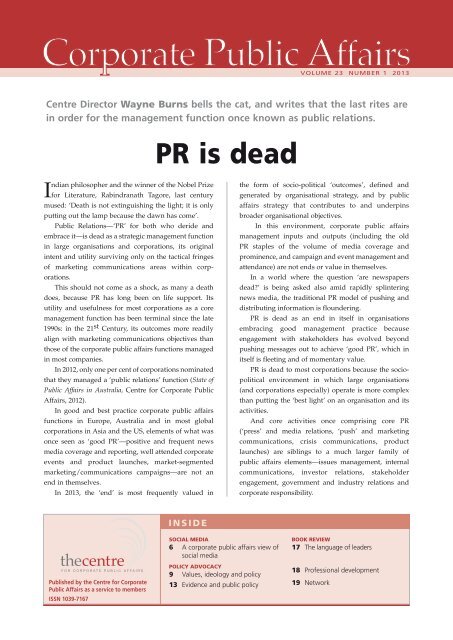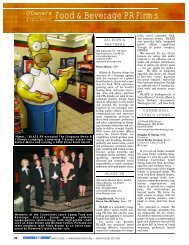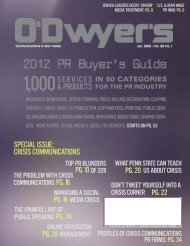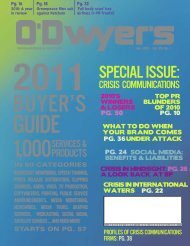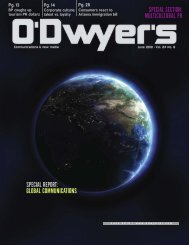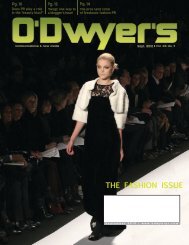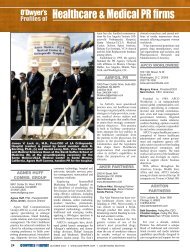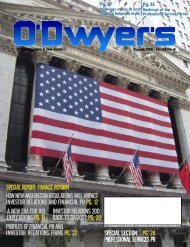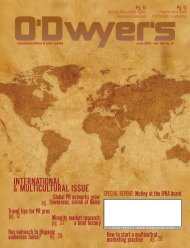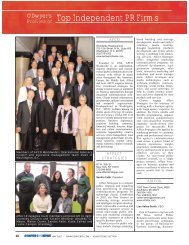"PR is Dead." (PDF) - Odwyerpr.com
"PR is Dead." (PDF) - Odwyerpr.com
"PR is Dead." (PDF) - Odwyerpr.com
You also want an ePaper? Increase the reach of your titles
YUMPU automatically turns print PDFs into web optimized ePapers that Google loves.
Corporate Public Affairs Vol 23: No 1, 2013VOLUME 23 NUMBER 1 2013Centre Director Wayne Burns bells the cat, and writes that the last rites arein order for the management function once known as public relations.<strong>PR</strong> <strong>is</strong> deadIndian philosopher and the winner of the Nobel Prizefor Literature, Rabindranath Tagore, last centurymused: ‘Death <strong>is</strong> not extingu<strong>is</strong>hing the light; it <strong>is</strong> onlyputting out the lamp because the dawn has <strong>com</strong>e’.Public Relations—‘<strong>PR</strong>’ for both who deride andembrace it—<strong>is</strong> dead as a strategic management functionin large organ<strong>is</strong>ations and corporations, its originalintent and utility surviving only on the tactical fringesof marketing <strong>com</strong>munications areas within corporations.Th<strong>is</strong> should not <strong>com</strong>e as a shock, as many a deathdoes, because <strong>PR</strong> has long been on life support. Itsutility and usefulness for most corporations as a coremanagement function has been terminal since the late1990s: in the 21 st Century, its out<strong>com</strong>es more readilyalign with marketing <strong>com</strong>munications objectives thanthose of the corporate public affairs functions managedin most <strong>com</strong>panies.In 2012, only one per cent of corporations nominatedthat they managed a ‘public relations’ function (State ofPublic Affairs in Australia, Centre for Corporate PublicAffairs, 2012).In good and best practice corporate public affairsfunctions in Europe, Australia and in most globalcorporations in Asia and the US, elements of what wasonce seen as ‘good <strong>PR</strong>’—positive and frequent newsmedia coverage and reporting, well attended corporateevents and product launches, market-segmentedmarketing/<strong>com</strong>munications campaigns—are not anend in themselves.In 2013, the ‘end’ <strong>is</strong> most frequently valued inthe form of socio-political ‘out<strong>com</strong>es’, defined andgenerated by organ<strong>is</strong>ational strategy, and by publicaffairs strategy that contributes to and underpinsbroader organ<strong>is</strong>ational objectives.In th<strong>is</strong> environment, corporate public affairsmanagement inputs and outputs (including the old<strong>PR</strong> staples of the volume of media coverage andprominence, and campaign and event management andattendance) are not ends or value in themselves.In a world where the question ‘are newspapersdead?’ <strong>is</strong> being asked also amid rapidly splinteringnews media, the traditional <strong>PR</strong> model of pushing andd<strong>is</strong>tributing information <strong>is</strong> floundering.<strong>PR</strong> <strong>is</strong> dead as an end in itself in organ<strong>is</strong>ationsembracing good management practice becauseengagement with stakeholders has evolved beyondpushing messages out to achieve ‘good <strong>PR</strong>’, which initself <strong>is</strong> fleeting and of momentary value.<strong>PR</strong> <strong>is</strong> dead to most corporations because the sociopoliticalenvironment in which large organ<strong>is</strong>ations(and corporations especially) operate <strong>is</strong> more <strong>com</strong>plexthan putting the ‘best light’ on an organ<strong>is</strong>ation and itsactivities.And core activities once <strong>com</strong>pr<strong>is</strong>ing core <strong>PR</strong>(‘press’ and media relations, ‘push’ and marketing<strong>com</strong>munications, cr<strong>is</strong><strong>is</strong> <strong>com</strong>munications, productlaunches) are siblings to a much larger family ofpublic affairs elements—<strong>is</strong>sues management, internal<strong>com</strong>munications, investor relations, stakeholderengagement, government and industry relations andcorporate responsibility.i n s i d ePubl<strong>is</strong>hed by the Centre for CorporatePublic Affairs as a service to membersISSN 1039-7167SOCIAL MEDIA6 A corporate public affairs view ofsocial mediaPOLICY ADVOCACY9 Values, ideology and policy13 Evidence and public policyBOOK REVIEW17 The language of leaders18 Professional development19 Network
Corporate Public Affairs Vol 23: No 1, 2013A death in the family was notunexpectedPublic affairs practitioners working in their professionfor some years will be hardly surpr<strong>is</strong>ed that <strong>PR</strong> hasbeen a critical patient for a decade, and has been onits last legs since extensive use of social media beganamputating the model of ‘pushing out’ and d<strong>is</strong>tributinginformation to generate ‘news’.Though it has not been entirely linear, organ<strong>is</strong>ationsnurturing corporate public affairs management functionshave been carefully defining and understandingstakeholders that most influence and impact on theenvironment that enables them to operate (their‘enabling’ environment).Th<strong>is</strong> has seen organ<strong>is</strong>ations focus their engagementefforts on defined and often small groups of stakeholders.Understanding the attributes, <strong>is</strong>sues andattitudes of those stakeholders cannot be achievedthrough traditional public relations.And stakeholders such as customers or clients,though frequently representing a stakeholder category<strong>com</strong>pr<strong>is</strong>ing a large number of individuals, cannot beassigned as a broad ‘public’ to be understood, reachedand influenced via <strong>PR</strong> tools and methods.The splintering media habits of consumers—including large numbers globally who are selfpubl<strong>is</strong>hersvia social media—has turned mass channel<strong>com</strong>munication (a core element of traditional <strong>PR</strong>) onits head.D<strong>is</strong>ruption of the traditional mass media modelby social media in itself represents a challenge to theex<strong>is</strong>tence of <strong>PR</strong> and its modus operandi. When marriedwith stakeholders’ expectations of not only being‘<strong>com</strong>municated to’ by corporations and governmentsvia mass media channels around their interests, <strong>is</strong>suesand concerns, but being engaged, then the traditional<strong>PR</strong> model <strong>is</strong> no longer viable.Most large, well-managed organ<strong>is</strong>ations are seekingto have conversations with their stakeholders. Suchdialogue cannot occur via ‘push’ <strong>com</strong>municationchannels that are part and parcel of the <strong>PR</strong> model.Model behaviourThe good practice model for corporate public affairs <strong>is</strong>character<strong>is</strong>ed by management thinking and activity toinfluence socio political out<strong>com</strong>es as a means of deliveringorgan<strong>is</strong>ational strategy.Practitioners working within th<strong>is</strong> model do so withan eye to the organ<strong>is</strong>ation’s long-term social licenseto operate with stakeholders, sustainable shareholderreturns, and strong employer brand to attract and retaingood people.The modern public affairs management function—described by the Centre as ‘the window in, and thewindow out’ of an organ<strong>is</strong>ation, and the function whichseeks to help the organ<strong>is</strong>ation interpret and influence itssocio-political environment—<strong>is</strong> very different from how<strong>PR</strong> <strong>is</strong> defined.The Public Relations Society of America definespublic relations as:'a strategic <strong>com</strong>munication process that builds mutuallybeneficial relationships between organizations andtheir publics.' (http://www.prsa.org/About<strong>PR</strong>SA/PublicRelationsDefined, April, 2013)The Public Relations Institute of Australia offers th<strong>is</strong>definition:‘... the management function which evaluates publicattitudes, identifies the policies and procedures of anindividual or an organ<strong>is</strong>ation with the public interest,and plans and executes a programme of action to earnpublic understanding and acceptance’. (<strong>PR</strong>IA, www.pria.<strong>com</strong>.au, March 14, 2013)And in 2013, Philip Lesly’s definition, cited on the<strong>PR</strong>IA’s website also:‘...helping an organ<strong>is</strong>ation and itspublics adapt mutually to each other’. (Handbook of PublicRelations and Communication, 1990)Those who have observed how the public affairsfunction has developed in large organ<strong>is</strong>ations internationallywould recogn<strong>is</strong>e that these definitions were aptto meet the needs of large organ<strong>is</strong>ations in the 1970sand 1980s.At the beginning of the second decade of the 21stcentury, good practice corporate public affairs seeks notonly to inform the public, but to involve d<strong>is</strong>tinct groupsof stakeholders in the organ<strong>is</strong>ation’s endeavours, andto influence the socio-political environment and createopportunities for strategy to be achieved.The 1980s and 1990s approach to <strong>PR</strong>—manifestedby activity to secure ‘positive’ media reports and ‘coverage’of a <strong>com</strong>pany (frequently ‘monet<strong>is</strong>ed’ by applyingprint advert<strong>is</strong>ing rates per centimetre of coverage,or broadcast advert<strong>is</strong>ing rates per 30 seconds of newsreporting), hold corporate events (the success of whichdefined by the number of attendees) and secure speakingplatforms for the CEO or senior executives—no longerrepresents the value it once did. The managementcaravan has moved on, as have societal expectations of
Corporate Public Affairs Vol 23: No 1, 2013Exhibit 1: Evolution of corporate public affairs — Australia and Asia, 1985 to 2010Marketing Comms Public Relations Corporate Comms Corporate Public Affairs• Opportun<strong>is</strong>tic• Events-driven• Collateral-focused• Marketing ethos• Brand = image =reputation• Brand management =reputation• Heavy focus andemphas<strong>is</strong> on channels• Emphas<strong>is</strong> oninputs/activity• Events-drivenexternal and internal• ‘Good news’ mediarelations and brandplacement• Brand profile focus• Channels and notstrategy-driven• Reliance on corporatehospitality externally• Brand management, notreputation management• Emphas<strong>is</strong> on inputs andoutputs• Corporate <strong>com</strong>ms strategyin place for internal andexternal <strong>com</strong>munications• Community relationsstrategy in place• Financial <strong>com</strong>municationscapacity• Soph<strong>is</strong>ticated channelsand strategy management• Little marketing/<strong>com</strong>msactivity• Ad hoc <strong>is</strong>sues mgt• Emphas<strong>is</strong> on KPIs aroundinputs• Strategic input intocorporate strategy• Seat on senior managementteam with CEO• Public affairs strategy linkedto corporate strategy• Stakeholders mapped and<strong>com</strong>ms/engagementcalibrated to influencestakeholders and addresspotential and ex<strong>is</strong>ting <strong>is</strong>sues• Soph<strong>is</strong>ticated <strong>is</strong>sues mgt• Out<strong>com</strong>es measured andused as KPIsBasic Tactical StrategicSource: Centre for Corporate Public Affairs, 2010how corporations should interact with the <strong>com</strong>munitiesin which they operate.Corporate public affairs and <strong>PR</strong>In most large <strong>com</strong>panies and organ<strong>is</strong>ations in Australia,as well as many in Asia, the concept of public relations<strong>is</strong> one that <strong>is</strong> best understood as crafting and ‘pushing’messages out via channels—and via news media especially—toseek to put a <strong>com</strong>pany or organ<strong>is</strong>ation in themost positive light possible.The role of the corporate public affairs function today<strong>is</strong> far more <strong>com</strong>plex and demanding than seeking to placean organ<strong>is</strong>ation in the best light with the public. Andalthough reputation stewardship <strong>is</strong> a core focus of thecorporate public affairs management function, it <strong>is</strong> moresoph<strong>is</strong>ticated and nuanced than generating inputs andoutputs to generate ‘good press’ for an organ<strong>is</strong>ation.Contemporary corporate public affairs <strong>is</strong> far removedand evolved from public relations in that, when practicedand managed well, organ<strong>is</strong>ations seek to forgeand nurture strategic relationships with stakeholders—manyof them their own employees—as a responseto socio-political change and mores, and as <strong>com</strong>petitiveadvantage.Though it has not been linear, the contemporary corporatepublic affairs management function in Australiaand in most parts of Asia, evolved from a marketing<strong>com</strong>munications capability to one that <strong>is</strong> intrinsicallyinvolved in developing organ<strong>is</strong>ational strategy, andsenior management dec<strong>is</strong>ion-making.As Exhibit 1 illustrates, some elements of <strong>PR</strong> werethe evolutionary forbears of contemporary corporatepublic affairs. These elements were valuable tocorporations at a time when social and managementexpectations were different from what they are today.Corporate media relations, cr<strong>is</strong><strong>is</strong> <strong>com</strong>municationsand some aspects of <strong>com</strong>munity relations have theirroots in the tactical practice of <strong>PR</strong> as it ex<strong>is</strong>ted in the1980s and 1990s, dominated by channel-driven <strong>com</strong>municationsto put a <strong>com</strong>pany in the ‘best light’ in newsmedia reports.However, corporate public affairs d<strong>is</strong>ciplines suchas government relations, corporate responsibility, stakeholderrelations and <strong>is</strong>sues management share little oftheir heritage with traditional public relations.The management function that <strong>is</strong> corporate publicaffairs has evolved because of socio-political naturalselection and innovations in business management.Since the early 1990s, some <strong>PR</strong> attributes have beenabsorbed into corporate public affairs. As well, managementpractice has evolved to dictate that what used to bea number of public relations out<strong>com</strong>es, are today inputsand outputs to corporate public affairs out<strong>com</strong>es.One reason <strong>PR</strong> <strong>is</strong> dead in leading organ<strong>is</strong>ations <strong>is</strong>because inputs and outputs do not constitute value:‘positive’ media reports and well-attended corporateevents are inputs to corporate public affairs out<strong>com</strong>es,which include good corporate reputation, engagedstakeholders, a healthy corporate brand, and engagedemployees.The Centre has tracked the evolution of the corporatepublic affairs management function in Australia,Asia, the US, Europe and New Zealand for 25 years; andmost closely via its State of Public Affairs in Australia andState of Asia Public Affairs research studies and reports.Rather than the transactional management functionchampioned by public relations representativeorgan<strong>is</strong>ations, the contemporary public affairs
Corporate Public Affairs Vol 23: No 1, 2013management function in large organ<strong>is</strong>ationsExhibit 2: Elements: Corporate Public Affairs and Public Relations<strong>is</strong> as far away from <strong>PR</strong> asCONTEMPORARY CORPORATEHobart <strong>is</strong> from Vladivostok.PublIC AFFAIRSTRADITIONAL PUBLIC RELATIONSExhibit 2 illustrates the elements• Government relations• Media relationsof the integrated public affairs function• Public policy development• Product promotion/as managed in most corporationsin Australia (based on 2012 State of• Strategic media relations• Corporate responsibility<strong>com</strong>munications• Events management• Stakeholder engagement• Cr<strong>is</strong><strong>is</strong> <strong>com</strong>munication counselPublic Affairs in Australia data) and the• Issues management• Leadership <strong>com</strong>municationselements of public relations (collated• Cr<strong>is</strong><strong>is</strong> management (including • Marketing <strong>com</strong>municationsfrom public relations associated websitesand management literature by theCentre for Corporate Public Affairs instakeholder engagement and<strong>com</strong>munications)• Internal <strong>com</strong>munications• Strategic <strong>com</strong>municationscounsel• Employee engagementFebruary 2013).• Regulatory affairsOur analys<strong>is</strong> of the core elements • Investor relationsof public relations leads us to concludethat their management utility <strong>is</strong> as• Corporate reputation stewardship• Corporate <strong>com</strong>munity investment• Community relationsinputs and outputs to generate some• Corporate brand stewardshipof the out<strong>com</strong>es germane to good practice(stakeholder brand)corporate public affairs.A key insight into any assessmentof <strong>PR</strong> apropos corporate public affairs<strong>is</strong> that as well as an evolution ofnomenclature (corporate public affairs• Strategic business counselMeasurement of out<strong>com</strong>es(value)Source: Centre for Corporate Public Affairs, 2013Counting inputs and outputs(activity)seeks to engage ‘stakeholders’ <strong>com</strong>pared to public relationsseeking to <strong>com</strong>municate with ‘publics’), publicrelations <strong>is</strong> a transactional notion, relying heavily ontraditional news media channels and events to ‘promote’an organ<strong>is</strong>ation or <strong>is</strong>sue.It <strong>is</strong> worth noting at th<strong>is</strong> juncture that marketing<strong>com</strong>munications, a traditional staple of public relations(and core to the modus operandi of many a publicrelations agency), <strong>is</strong> not <strong>com</strong>monly a focus of corporatepublic affairs management.That <strong>is</strong> not to say that managing marketing <strong>com</strong>municationsinputs and outputs to achieve marketingout<strong>com</strong>es are not important to <strong>com</strong>panies. FMCG (fastmoving consumer goods) and retail <strong>com</strong>panies investconsiderably to fund marketing <strong>com</strong>munications activities.Most frequently today, marketing <strong>com</strong>municationsin large corporations are managed in marketing departments.scramble to work out how they can achieve the dialoguethat dominates social media platforms (that haschanged the manner in which billions of people consumenews and information to forge opinions), socialmedia globally has tried and condemned the old modelof <strong>PR</strong> push messaging.Most <strong>PR</strong> activity that was once executed by corporations<strong>is</strong> now frequently managed within <strong>com</strong>panymarketing departments, or outsourced to marketing orpublic relations agencies.And though the glow of <strong>PR</strong> still flickers in the DNAof many public relations agencies and consultanciesoffering services to large organ<strong>is</strong>ations, some <strong>PR</strong> shopshave shifted their value proposition up the socio-politicalevolutionary tree as well.Today, in markets such as Australia, many parts ofEurope, and in numerous multinational corporationsin Asia, these agencies are part of the supply chain forcorporate public affairs out<strong>com</strong>es (value).The limitations of ‘push’<strong>com</strong>municationsSocial media has changed markedly the <strong>PR</strong> model ofpushing out messages to entice news media channelsto carry them, and through that, ‘manage’ corporatereputation.As traditional news media, manifested in mastheads,radio frequencies and telev<strong>is</strong>ion stations,Evolution of corporate publicaffairs as a leadership functionAs Exhibit 3 illustrates, the management objectiveof the corporate public affairs function <strong>is</strong> to createvalue externally by being both a business enabler, andinternally via contributing to corporate strategy andorgan<strong>is</strong>ational dec<strong>is</strong>ion-making.
Corporate Public Affairs Vol 23: No 1, 2013In th<strong>is</strong> contemporary model, the function’s rolereaches significantly beyond the definitions of publicrelations from the Public Relations Society of America('... Public relations <strong>is</strong> a strategic <strong>com</strong>munication processthat builds mutually beneficial relationshipsbetween organ<strong>is</strong>ations and their publics') or the PublicRelations Institute of Australia ('... plans and executes aprogramme of action to earn public understanding andacceptance').The role and focus of the corporate public affairsfunction <strong>is</strong> not transactional, but strategic and longterm.The function does manage processes and executesprograms to engage stakeholders. However, th<strong>is</strong> <strong>is</strong>not an end itself. It <strong>is</strong> an input along the managementvalue chain (activity) to generate strategic out<strong>com</strong>es,including sustainable returns to shareholders, clients/customers, employees and other stakeholders.The corporate public affairs function in most largeorgan<strong>is</strong>ations in Australia has direct influence on andinput to whole-of-organ<strong>is</strong>ation strategy and dec<strong>is</strong>ions,either via its head reporting directly to the CEO, or byparticipating in strategic planning for the business.In 2012, 66 per cent of heads of function in largeAustralian organ<strong>is</strong>ations were members of their CEO’ssenior leadership team; 82 per cent of corporate publicaffairs leaders participated in strategic planning for thewhole organ<strong>is</strong>ation (State of Public Affairs in Australia,Centre for Corporate Public Affairs, 2012).It <strong>is</strong> difficult to contest that continuing evolutionof corporate public affairs as a strategic function hasd<strong>is</strong>placed public relations as an area of managementfocus in most large organ<strong>is</strong>ations.The integrated corporate public affairs functionoffers more value to organ<strong>is</strong>ations than <strong>PR</strong> once did,and the rasion d’etre of public relations, the power ofcrafting and pushing a message into the mass newsmedia, has waned.If it was the 1980s, we could find resonance in theevolution of corporate <strong>com</strong>munications and corporatepublic affairs and the death of <strong>PR</strong> in the popular songof that decade 'Video Killed the Radio Star'.However, Rabindranath Tagore was more elegant,and not triumphant about the fading of one light toac<strong>com</strong>modate another.Putting out the <strong>PR</strong> lamp has occurred because thedawn of stakeholder engagement and social media has<strong>com</strong>e. nExhibit 3: The value proposition of the contemporary corporate public affairs functionOrgan<strong>is</strong>ational value =capital/returns to stakeholders,including shareholders, employees,customers, other stakeholdersSeniormanagementand crossorgan<strong>is</strong>ationalinteractionOrgan<strong>is</strong>ationalstrategy and itsapplicationOrgan<strong>is</strong>ationaloperations andstakeholdertransactions,includingcustomersBoardGovernance,CEO and Seniormanagement,includingcorporatepublic affairsmanagementStakeholderinvolvementandreputationalcapitalSocio-political Enabling EnvironmentStrategic socio-political management, stakeholderengagement, <strong>is</strong>sues management, corporate responsibility
Corporate Public Affairs Vol 23: No 1, 2013S O C I A L M E D I ASocio-political media:a corporate publicaffairs view of socialmediaCentre Manager George On<strong>is</strong>iforoud<strong>is</strong>cusses how social media affects thesocio-political environment and itsimplications on the corporate publicaffairs practice.Social media has be<strong>com</strong>e a regular presence in ourlives, despite being a relatively new phenomenon.It <strong>is</strong> impossible to think of a world without it.But its novelty demands caution. How much canwe understand a phenomenon that <strong>is</strong> still developing?Social media’s fast-moving and shifting nature allowslittle time for reflection. The content that <strong>is</strong> producedand shared through social media demands continuousattention. New technologies and applications emergefaster than one can speculate ‘what next?’. It <strong>is</strong> easy toget caught in social media ‘hype’.But ‘hype’ <strong>is</strong> not substance. Public affairs practitionersneed to reflect on the implications of social mediabeyond its continuous alterations and constant feed ofinformation. To do so, they need to look at social mediaas a broad socio-political phenomenon, and understandhow it can affect their function’s responsibilities andstrategies.Social media <strong>is</strong> primarily understood as a <strong>com</strong>municationsand marketing channel. As such, its importancecan be easily measured by its reach and usage.For example, there are about twelve million Facebookusers in Australia. These users expend on average 25minutes during each Facebook session (Cowling 2013).These stat<strong>is</strong>tics can justify why social media should beintegrated in <strong>com</strong>munications and marketing strategies.The corporate public affairs function’s responsibilities,however, reach beyond <strong>com</strong>munications. Aneffective corporate public affairs function reduces itsorgan<strong>is</strong>ation’s socio-political r<strong>is</strong>k and business costs,and stewards the organ<strong>is</strong>ation’s corporate reputation.It <strong>is</strong> crucial to the function’s success to monitor andunderstand the socio-political environment, and remainon top of the economic, political, and technologicaldevelopments that can affect th<strong>is</strong> environment.These responsibilities call for an understanding ofsocial media’s effect on the socio-political environment.How does social media contribute to the regulatory andsocial r<strong>is</strong>k and costs of operating an organ<strong>is</strong>ation?The assessment of such a question demands intelligencethat <strong>is</strong> difficult to attain at such an early stageof the phenomenon’s life cycle. However, the public’sand the government’s use of social media can be investigatedto provide initial insights.Social media and the publicThe perceptions, agendas, actions or inactions of socialgroups can have an impact on an organ<strong>is</strong>ation’s goalsand their implementation, particularly at a local level.These factors, which contribute to an organ<strong>is</strong>ation’s‘social license to operate’, can affect the social costs andr<strong>is</strong>ks of operating an organ<strong>is</strong>ation.Social media can intensify the formation, reach anddiversity of these social factors, more so than traditionalmedia.Social media users are not solely consumers of content.They can create content, or can collaborate withothers to create content. They can develop messages orexpress views, including about organ<strong>is</strong>ations, and sharethese publicly. The reach and the ease with which thesecan occur are unprecedented.The co-sharing and co-development of content atsuch a mass scale implies that social media users caninfluence the views, attitudes, and actions of otherusers. Such potential influence can have direct marketconsequences. It suggests that an organ<strong>is</strong>ation doesnot have the exclusive control of the messages and thecontent that are publicly available about the way itconducts its business, and about its products and services.Social media elevates social <strong>com</strong>mentary and socialinfluences to be<strong>com</strong>e key contributors to an organ<strong>is</strong>ation’spublic profile. In th<strong>is</strong> manner, social media minim<strong>is</strong>esthe occurrence and influence of the organ<strong>is</strong>ation’spublic image—the desired internal picture projected toexternal audiences—and elevates the importance andinfluence of organ<strong>is</strong>ational reputation—the actual perceptionsof internal and external audiences.The elevation of the influence of an organ<strong>is</strong>ation’sreputation above the influence of its image can createextraordinary <strong>com</strong>plexities and challenges. These
Corporate Public Affairs Vol 23: No 1, 2013<strong>com</strong>plexities stem from the diversity inherent withinthe public, and in consequence, the excessive amountof information created by th<strong>is</strong> diversity.The public <strong>is</strong> not a universal and coherent group.An organ<strong>is</strong>ation’s reputation <strong>is</strong> likew<strong>is</strong>e diverse—it canbe positive or negative, it can vary depending on geographies,time, <strong>is</strong>sues and individuals, and it can changeor can be influenced to change. When th<strong>is</strong> diversity<strong>is</strong> channeled through social media it creates an aston<strong>is</strong>hing‘no<strong>is</strong>e’ of content and information. Althoughoverwhelming, th<strong>is</strong> ‘no<strong>is</strong>e’ be<strong>com</strong>es the bas<strong>is</strong> of anorgan<strong>is</strong>ation’s public profile in the growing relevantaudiences.Social media, public policy andpoliticsThe stability of the political environment, and the regulationsand policies that guide a state’s economic activitycan significantly impact an organ<strong>is</strong>ation’s operations.The citizens’ use of social media can influence th<strong>is</strong>political environment, either by unsettling it or byassuring its accountability through participation andsupport. The level of th<strong>is</strong> influence, however, remainsunknown.Citizens around the world have used social mediato manifest their political identity and power by creatingonline groups, and then by assembling in thephysical world to demonstrate their views. Althoughthese events have been covered extensively by traditionalmedia, it <strong>is</strong> unclear how much influence socialmedia can have on the national politics of a state. Socialmedia may have had a positive influence in ass<strong>is</strong>tingloosely coordinated publics demand change—forexample, in Moldova in 2009, Bangkok in 2010, and inEgypt in 2011—but its effect in actually changing thepolitical landscape of these states <strong>is</strong> d<strong>is</strong>putable (Shirky2011).Social media users, however, tend to be more civicallyand politically active than non-users (Raine et al2012). Th<strong>is</strong> suggests social media can have a more significantand positive effect in enhancing opportunitiesfor political participation, and opening new spaces foractive citizenship in democratic states (Bohler-Muller &van der Merwe 2011).Democratic governments, and particularly governmentsin the U.K, Canada and Australia, are movingtowards a more stakeholder-centric managementand governance paradigm. In th<strong>is</strong> emerging paradigm,stakeholder and public participation in policydevelopment and service delivery <strong>is</strong> increasing, and <strong>is</strong>viewed as desirable.Social media’s encouragement of broad <strong>com</strong>municationand collaboration between individuals <strong>is</strong> a naturalfit for th<strong>is</strong> paradigm. Governments have used socialmedia to engage the public in efforts towards furthertransparency, and broader and deeper public influencein dec<strong>is</strong>ions and implementation relating to policymakingand service delivery. However such efforts aremarred by significant limitations, and further work inth<strong>is</strong> area <strong>is</strong> yet to be <strong>com</strong>pleted (Note: a related articleon stakeholder engagement and innovation in the publicsector was publ<strong>is</strong>hed in volume 21/number 2 of th<strong>is</strong>newsletter).Implications for corporate publicaffairsThe implications of social media’s influence in the sociopoliticalenvironment are both tactical and strategic.The r<strong>is</strong>ing importance of an organ<strong>is</strong>ation’sreputation over its image suggests that corporatepublic affairs practitioners need to re-evaluate theirunderstanding of how much control an organ<strong>is</strong>ationcan assert over the messages and the content that definethe public’s perceptions of it. Such control will not stemexclusively from the organ<strong>is</strong>ation’s own generated content,but will extend to include content that <strong>is</strong> producedand d<strong>is</strong>seminated online by the public through socialmedia.The establ<strong>is</strong>hment of social media ‘no<strong>is</strong>e’ as the newstatus quo implies the strategic importance of monitoringand analysing th<strong>is</strong> ‘no<strong>is</strong>e’. As such, knowledgeabout how to monitor and analyse social media contentbe<strong>com</strong>es an important skill, and perhaps an asset, tosuccessful corporate public affairs functions.The development of a strong voice for each organ<strong>is</strong>ation,which will form part of th<strong>is</strong> social media ‘no<strong>is</strong>e’,<strong>is</strong> also paramount. The ability to create social mediacontent that <strong>is</strong> relevant and engaging to an already‘bombarded’ audience <strong>is</strong> a crucial and challenging taskfor practitioners, particularly now that video <strong>is</strong> themost preferred and effective d<strong>is</strong>play of social mediacontent.Public affairs practitioners should be<strong>com</strong>e familiarwith the emerging management and governance paradigmin which governments involve citizens in policymakingand service delivery, including through socialmedia. Th<strong>is</strong> emerging paradigm may influence thegovernment’s expectations of an organ<strong>is</strong>ation’s legal,
Corporate Public Affairs Vol 23: No 1, 2013P O L I C Y A D V O C A C YValues, ideology andpolicyIn ac<strong>com</strong>panying articles, Centre ChairmanGeoff Allen examines some of theprocesses and dynamics of advocacy anddialogue between political influencersand dec<strong>is</strong>ion makers. In th<strong>is</strong> article, hed<strong>is</strong>cusses some of the psychological andideological impediments to policy resolution.If there appears to be any broad consensus in Australia,it <strong>is</strong> that we are poorly served by petty squabblesbetween politicians, and by poor, ad hoc, poll and factiondriven dec<strong>is</strong>ions.The basic drivers are not new. I remember BillyMcMahon staring at Gough Whitlam’s navel and tellinghim in the Reps chamber ‘politics <strong>is</strong> staying in office’.And despite some periods of relative calm, leadershipinstability has been the norm rather than the exceptionsince Bob Menzies.Fortunately for Australia, and above politics at leastsince the 1980s, there has been a reasonable level ofconsensus, albeit high level, amongst the policy elitesacross the major political divides about approaches toeconomic management. Notwithstanding some influence,the more extreme ideologies of left and right, forexample anti-capital<strong>is</strong>m, rabid national<strong>is</strong>m, and environmentalfundamental<strong>is</strong>m, are still at the margins ofpower.The problem <strong>is</strong> that within th<strong>is</strong> broadly consensualunderstanding, which largely supports a marketeconomy and constraints on the role of government inthe economy, our adversarial political system impairsthe most rational resolution of specific policy <strong>is</strong>sues.While of course dressed in public interest, the debatesare character<strong>is</strong>ed by refusal to see value and seriouslyengage on each side’s proposals, rather d<strong>is</strong>torting themand opportun<strong>is</strong>tically creating ‘straw-men’ to appeal tothe popular prejudices they feed.Th<strong>is</strong> <strong>is</strong> somewhat ironic at a time when the currentemphas<strong>is</strong> in elite d<strong>is</strong>course <strong>is</strong> about the significance ofevidence as the bas<strong>is</strong> for policy-making (see ac<strong>com</strong>panyingarticle ‘Evidence and public policy’).That politics trumps policy can be seen in F DRoosevelt’s reply to a bunch of lobby<strong>is</strong>ts on a controversial<strong>is</strong>sue, ‘OK you’ve convinced me; now go outand bring pressure on me’. A local version was JohnHoward’s <strong>com</strong>ment to business leaders when they werepushing him towards introducing a GST, even requiringa broken election prom<strong>is</strong>e to pursue it, (to paraphrase) ‘Iwill run with it if you can create an environment whereI can do so without losing the election.’Or Jeff Kennett’s refusal to overturn a local councildec<strong>is</strong>ion on the location of a prescribed waste facility(again to paraphrase), ‘we want th<strong>is</strong> but don’t expectme to waste political capital on th<strong>is</strong> when you havedone such a lousy job with the <strong>com</strong>munity.’Th<strong>is</strong> <strong>is</strong> a major challenge for those seeking rationalout<strong>com</strong>es on important <strong>is</strong>sues. The primacy of politics<strong>is</strong> not to d<strong>is</strong>regard the power of policy research andrational argument, but in an environment of popul<strong>is</strong>tpolitics, effective advocacy <strong>is</strong> more likely the degreeto which <strong>com</strong>mon ground can be found between theplayers.While it <strong>is</strong> difficult to penetrate the shouting, th<strong>is</strong>can most easily be achieved by first seeking values heldin <strong>com</strong>mon and finding what can be agreed, ratherthan focussing, at the outset of an argument, on whatdivides.Values, ideologies and policyprioritiesDespite abhorrence of current political shenanigans,there <strong>is</strong> more <strong>com</strong>monality in basic values than thetone of public d<strong>is</strong>course and political debate wouldsuggest.It <strong>is</strong> <strong>com</strong>mon to assert that individuals or groupshave different ‘sets of values’ (Labor values, Liberal valuesetc.). When probed th<strong>is</strong> may not be so much a differencein absolute values, but in their relative weightingwithin a particular ideological framework.It has been noted that normally groups or individualstend to ‘deal with <strong>is</strong>sues only within the frameworkof their own ideological assumptions withoutsubjecting them to critic<strong>is</strong>m’ (GC Lodge and EE Vogel1987).Accordingly individuals or groups can be operatingon the bas<strong>is</strong> of shared values but differ ideologically—andconsequently divide strongly on—policyprescriptions because they have different perceptions ofhow the world works.The ‘Hierarchy of accord’ (see Figure 1) represents<strong>com</strong>mon ‘values’ that are generally shared across the
Corporate Public Affairs Vol 23: No 1, 2013political and public policy divide. These values aretranslated through the filter of ideology that tendsto predetermine how we react to policy options. Theillustrative ‘hierarchy’ of course heavily simplifies ourworld between ‘individual<strong>is</strong>t’ and ‘<strong>com</strong>munitarian’world views, though we know in practice that div<strong>is</strong>ionsare much more <strong>com</strong>plex.To ass<strong>is</strong>t practical politics and the resolution of<strong>is</strong>sues, a <strong>com</strong>monality of values can be found betweenthose who are the ideologically opposed by starting atthe top of the hierarchy, for example over long sessionswith red wine and cheese, or on moonlight walks on thebeach. Much of what we have in <strong>com</strong>mon <strong>is</strong> not surpr<strong>is</strong>ing,and that <strong>is</strong> the best place to start.As noted, our value aspirations are translatedthrough the pr<strong>is</strong>m of ideology. We can acquire theseideological frames of reference (for example individual<strong>is</strong>tor <strong>com</strong>munitarian outlooks) through a variety ofmeans. It could be the influences of family philosophy,an influential teacher or book, or imbued class assumptions,all re-enforced by our perceptions of behavioursaround us. Once imbibed, ideologies are hard to shiftand are self reaffirming as we filter our life’s experiencethrough them.The pr<strong>is</strong>m of ideology leads people with shared valuesdown different political and policy paths.Those with an individual<strong>is</strong>t ideological orientationwant to limit protection against market forces,rely on individual incentives, and reduce regulation.Those with a <strong>com</strong>munitarian orientation prefer equityof out<strong>com</strong>es to equity of opportunity, more control ofmarkets, and more active government intervention todeal with <strong>is</strong>sues. Of course these are simplificationsand general<strong>is</strong>ations; the response of individuals can bemore <strong>com</strong>plex.Those <strong>com</strong>ing at policy through a strong ideologicallens tend to see their policy solutions as self evident,and can be quick to see stupidity, or base motiveand malevolence, in those who oppose what they advocate.Figure 1 Hierarchy of accordValues• social equity• social cohesion• national prosperity• ecological sustainability• increased <strong>com</strong>petitionrequired to increaseeconomic growth• faster structuraladjustment required• in<strong>com</strong>e differentialsrequired as incentive• maintenance of a minimalsocial safety net• eliminate industryprotection• reduce public expenditure• international<strong>is</strong>e economy• environment protectionthrough market incentives• values best achievedthrough individualeffort• <strong>com</strong>petition andmarkets createprosperity• government intrudesand d<strong>is</strong>tortsIdeologies• values best achievedthrough <strong>com</strong>munityeffort* <strong>com</strong>petition cancreate inequities andmarkets exploitative• government includesand protectsPolicy Priorities• managed, gradual • employment<strong>com</strong>petition required• staged structuraladjustment required• equal opportunity• environment protectionthrough regulation• labour market interventionrequired• current social safety netrequires extension“guarantees” required• pace of technologicalchange should be slowed• broad job creationprograms required• social equity requires activegovernment intervention• environment preservationrequires active governmentintervention/veto• industry sectors requireprotection• increase corporate taxationand regulation to supportextended safety net andcontrol market10
Corporate Public Affairs Vol 23: No 1, 2013Factors that further divideThe development of world view and policy prescriptionsthat emerge from our basic values through ourideologies are <strong>com</strong>plicated and often skewed by anumber of additional factors that are so entangled thateven the most analytical and objective of us find it hardto separate them. They exacerbate the already conflictingapproaches to policy debates that are intrinsic to ourpolitical system.Vested interests—these can <strong>com</strong>plicate the transitionfrom values to policy by the natural tendency torational<strong>is</strong>e these interests. Through th<strong>is</strong> process, oftensubconsciously, the high moral ground, or concept ofrights and entitlements are corralled in pursuit of theinterests postulating them. Some of th<strong>is</strong> <strong>is</strong> cynical, some<strong>com</strong>es from losing objectivity. Examples are obvious tod<strong>is</strong>interested observers, when sectional interests seekrule exemptions, subsidies or regulations supportive oftheir interests or those of their constituents.Occupational myopia—th<strong>is</strong> <strong>is</strong> the tendency to overvaluethe significance of <strong>is</strong>sues one <strong>is</strong> most fullyinvolved in or professionally <strong>com</strong>mitted to. We expectart<strong>is</strong>ts to especially value the aesthetic; business leadersto support economic efficiency, environmental<strong>is</strong>ts—thestate of nature; scient<strong>is</strong>ts—research etc. In addition, weshould expect interest groups that are formed to articulatetheir interests will have their world-view impactedover time by their m<strong>is</strong>sion, and see their occupationalconcerns d<strong>is</strong>proportionately embedded in their v<strong>is</strong>ionfor Australia.Dynamics of advocacy—techniques to <strong>com</strong>pete onpolicy prescriptions include media management, sponsorshipof research conducive to the preferred out<strong>com</strong>e,celebrity endorsement and advert<strong>is</strong>ing. We are easilylocked into fixed positions to ‘save face’. Advocates areprone to negative stereotyping of their opponents, attributingfalse motive, reducing <strong>is</strong>sues to black and white,d<strong>is</strong>honest creation of ‘straw men’, and pejorativelylabelling of policy opponents, for example, ‘economicBOX 1: Positive sum solutionsIndustrial Relations: A number oftimes a senior business associationexecutive and ACTU leader satdown for a long lunch with pastaand red wine to d<strong>is</strong>cuss workplacepractices and industry policy. Itwasn’t to do industrial deals, butdid mitigate entrenchment ofconflicting positions. Media hostsexpressed d<strong>is</strong>appointment at thelevel of agreement and mutualrespect after a program that was‘d<strong>is</strong>appointing telev<strong>is</strong>ion’.Consumer Leg<strong>is</strong>lation: A financeindustry association executivemet with the head of the majorrelevant consumer lobby toreview new draft leg<strong>is</strong>lation,away from their constituenciesin the first instance. The normalpractice had been to fight overthe whole bill and end up withresults unsat<strong>is</strong>factory to both. Theywere amazed at how much theycould agree on and both live with,leaving only one or two elementsto be fought over.Indigenous Relations: At the heightof conflict over land rights, amining industry CEO took a bunchof h<strong>is</strong> peers to a remote area to sitdown with indigenous leaders overa couple of days to talk throughmutual concerns. They deliberatelykept th<strong>is</strong> away from politiciansand the media, and didn’t invitetheir association executives orindigenous ‘adv<strong>is</strong>ors’. Both sides<strong>is</strong>sued excited statements aboutthe level of agreement and mutualunderstanding generated. Positiverelationships were also establ<strong>is</strong>hedthat helped resolve subsequent<strong>is</strong>sues.GST: After a number ofattempts to introduce a broadbasedconsumption tax, andacknowledging the politicaldifficulties involved, some businessleaders sought out the Democratsand Australian Council of SocialServices, both organ<strong>is</strong>ations thathad been vehemently opposed toit. By exploring together how sucha tax could further the values theyshared, and after <strong>com</strong>prom<strong>is</strong>esthat ac<strong>com</strong>modated some majorconcerns, they were able topresent a supportive united front.Th<strong>is</strong> provided enough politicalprotection for the government tointroduce the measure.Drunk Driving, an American Classic:Following the alcohol-related roaddeaths of their children a numberof women started a remarkablysuccessful grassroots organ<strong>is</strong>ationthat spread across the USA calledMothers Against Drunk Driving(MADD). It attacked the alcoholindustry generally, but whenrepresentatives of the industrysat down with them they agreedthe real target (shared with theindustry) was irresponsible ‘drivingunder the influence’. The industryoffered to help them by fundinga media campaign and othersupport against drunk drivingwhile MADD narrowed theirfocus to that <strong>is</strong>sue.11
Corporate Public Affairs Vol 23: No 1, 2013rational<strong>is</strong>t’, ‘greenie’, ‘leftie’ or in the ‘latte set’.Ambit claiming—th<strong>is</strong> accepted practice in industrialrelations has its counterpart in general policy advocacy.By th<strong>is</strong> process individual sectors or interests areeffectively staking a claim for dec<strong>is</strong>ions or resources,irrespective of the legitimacy of other claims, tomaxim<strong>is</strong>e their position in the inevitabletrade-offs or <strong>com</strong>prom<strong>is</strong>es requiredin policy making. The media ofcourse exacerbates these conflicts bypresenting the more stark and dramaticdifferences, and by easy resortto the ‘usual suspects’ who are outspokenand ‘good copy’.Constant assertion of a positionand defence against alternative perspectivestends to lock us into thepropositions we are making, furtherlimiting our capacity to see otherperspectives.So what for public affairs?As suggested, thedynamics of advocacy<strong>com</strong>e together at a highpoint in the operation ofadversarial party politicswhere it <strong>is</strong> considered aweakness to see merit inan opponent’s case, andfollow to question theveracity of one’s ownWhenever an <strong>is</strong>sue ar<strong>is</strong>es that affects the interests of citizensor groups, the overwhelming propensity of advocates<strong>is</strong> to go straight to the lowest level in the hierarchyof accord. Th<strong>is</strong> generates immediate conflict betweenthe ideologically divergent. Each preferred policy position<strong>is</strong> asserted as absolute in the public interest and thedynamics of advocacy kick in to create a zero-sum gamewith bad motive or ignorance attributed to opponents.Positions be<strong>com</strong>e locked in a contest before the media(and constituencies in the case of industry associations,unions, or other NGOs), where to <strong>com</strong>prom<strong>is</strong>e <strong>is</strong> to loseface or deepen resentment, further polar<strong>is</strong>ing debate.In th<strong>is</strong> testosterone-enhanced conflict, optimum policyout<strong>com</strong>es are lost. Triumph for politics over policy.Experience from th<strong>is</strong> seasoned campaigner demonstratesa more productive route to take. That <strong>is</strong> to startfrom an acceptance of shared fundamental values, andunderstanding of the ideological drivers that we, and<strong>is</strong>sues adversaries, have that have led to our differentpolicy positions on the same set of data.Research and experience has also demonstratedthat interpersonal relationships, where <strong>com</strong>mon touchpointscan be found, reduce our propensity to attributebad motive and the negative stereotyping that mitigatesthe prospect of <strong>is</strong>sues resolution.The main lesson for us <strong>is</strong> that by jumping the fencefrom our entrenched positions to the other side, extendinggood will through acknowledgment of shared basicvalues, and attempting to understand what <strong>is</strong> drivingalternative perspectives of what works and doesn’twork (ideologies and their roots), we will get to betterout<strong>com</strong>es, and at less cost. To do th<strong>is</strong> helps us to starta dialogue with goodwill. It helps us understand thebona fides and real <strong>is</strong>sues of opponentsto maxim<strong>is</strong>e what <strong>is</strong> acceptableto both sides.Fundamentally different (andbetter) out<strong>com</strong>es have <strong>com</strong>e from<strong>is</strong>sue negotiations that start by tryingto focus on what objectives areheld in <strong>com</strong>mon, what might beacceptable, leaving those aspectsthat are irreconcilable to be the morenarrow focus for d<strong>is</strong>pute and resolution.Examples in Box 1 illustrate howth<strong>is</strong> can work.One should not be naive aboutpolicy conflict. Ideological conflicts are real and dodrive policy. Vested interests trump public interests inmost cases. Party politics remain toxic, and the conflictinginterests of business and NGOs are still used asproxies in the wars between contending political parties,and by the media to dramat<strong>is</strong>e news stories.However, I have observed that over the past twentyyears there has been a remarkable shift in the way businessand non-business NGOs deal with <strong>is</strong>sues. Many(but by no means all) NGOs are more ready to seethe value and needs of business, and business <strong>is</strong> moresensitive to the social and environmental impacts oftheir activities. Both sides are more willing to acknowledgeshared values and work towards mutuality ofinterest.Success of th<strong>is</strong> more open and empathetic approachto policy dialogue has been pervasive, producing manybenefits and positive sum game solutions. Starting ad<strong>is</strong>cussion by optim<strong>is</strong>ing what <strong>is</strong> held in <strong>com</strong>mon whileleaving the real conflict points to be the focus of the contest<strong>is</strong>, from th<strong>is</strong> writer’s experience, a no-brainer. nReferencesLodge, GC and Vogel, EE Eds. 1987, Ideology and NationalCompetitiveness; An Analys<strong>is</strong> of Nine Countries, HarvardBusiness School Press12
Corporate Public Affairs Vol 23: No 1, 2013P O L I C Y A D V O C A C YEvidence and publicpolicyIn our current environment of politicaland poll driven government, th<strong>is</strong>article by Centre Chairman Geoff Allenlooks at the development and role ofresearch-based advocacy and the needfor its business use.In a time where political d<strong>is</strong>course <strong>is</strong> conducted inglib fifteen second tele-grabs and we are observingthe most political and poll-driven policy approaches inrecent h<strong>is</strong>tory, it <strong>is</strong> a little ironic that the strongest everstatements are being made in support of evidence as thekey to public policy (for example, from eminent publicservants, as Ken Henry, Terry Moran, Gary Banks andMartin Parkinson).The ac<strong>com</strong>panying article, ‘Values, ideology andpolicy’ focuses on the subjective element of policythinking. Th<strong>is</strong>, together with poll-driven opportun<strong>is</strong>m,trumps research-based evidence. However the roleof the latter <strong>is</strong> important, and apart from informingpolicy, can help create political space for good policyand reform.Governments these days are under scrutiny fromsoph<strong>is</strong>ticated <strong>com</strong>mentators and policy protagon<strong>is</strong>ts,and need for credibility’s sake to find a public policyrationale to back up politically motivated dec<strong>is</strong>ions.It used to be much less so.As <strong>is</strong> still the case in many countries, Australianpolitics until the late 1970s tended to operate in a closedsystem of networks, including vested interests andold boy networks, that enabled dec<strong>is</strong>ions to be madewithout serious analys<strong>is</strong> and public contestability.As <strong>is</strong> typical of these insider systems, the processwas heavily biased to those with the closest contacts,without seriously testing objective evidence. A debatewithin the McMahon cabinet in 1971 on the relativeutility of accelerated depreciation and lowering acrossthe-board<strong>com</strong>pany in<strong>com</strong>e tax provides an illustration.McMahon came to Canberra after a weekend ofcontact with friends from the Sydney financial sector,declaring he had consulted ‘business’, and ‘business’preferred the <strong>com</strong>pany in<strong>com</strong>e tax measure. Th<strong>is</strong> wasclearly good for finance <strong>com</strong>panies, but not, as evidencewould have shown, the preferred position of the capital-intensivemanufacturing and mining sectors thatwere absent from h<strong>is</strong> d<strong>is</strong>cussions, or necessarily for theeconomy. The relative impact on investment, employmentand productivity was very much a second orderconsideration.When <strong>is</strong>sues went public they were not arguedby detailed research but by a loud assertion of positions.One example was a press release by AssociatedChamber of Manufactures of Australia President, BobAnderson, asserting little more than its heading, ‘Don’tMonkey with Tariffs’.A number of major factors have moved Australianpolicy debate since then—at least in the policy elite—toa more soph<strong>is</strong>ticated and contestable level.The bureaucracyUntil the 1970s a tight group of knighted ‘PermanentHeads’ ran Canberra from the billiard table of theCommonwealth Club. Some were technically excellent,but like Sir Humphrey Appleby, they owed their hugeinfluence over policy and admin<strong>is</strong>trative out<strong>com</strong>es totheir skills in bureaucratic politics on which they spentmuch time.In the late 1970s, but particularly 1980s, we saw ashift in public service leadership to a group of young,highly trained, econom<strong>is</strong>ts (eg, B Frazer, V FitzGerald,M Keating, C Higgins, D Morgan). They reflected theliberal econom<strong>is</strong>t’s bias to markets, and argued withhard data against cosy government deals with interestgroups.Nowhere was th<strong>is</strong> new economic soph<strong>is</strong>ticationmore obvious than in the Tariff Board, which hashad several iterations and <strong>is</strong> now the ProductivityComm<strong>is</strong>sion.Establ<strong>is</strong>hed as an independent authority to reviewrequests for industry protection, the old Tariff Boardhad limited scope, loaded references in the protection<strong>is</strong>tcause, and no license to consider the economy-wideimpacts of its re<strong>com</strong>mendations to government. TheTariff Board fought long and hard to win the right tohave open enquiries where evidence was required, andto make public their re<strong>com</strong>mendations to government.Th<strong>is</strong> was res<strong>is</strong>ted by the old school that was losing thepower of the ‘insider’ paradigm.McEwen’s successor, Doug Anthony, said of th<strong>is</strong>new transparency, ‘government will find it will havegreat difficulty in rejecting the Comm<strong>is</strong>sion’s re<strong>com</strong>mendations,because if it does, it will lay itself open to a13
Corporate Public Affairs Vol 23: No 1, 2013great deal of public critic<strong>is</strong>m.’The Comm<strong>is</strong>sion, known by then as the IndustriesAss<strong>is</strong>tance Comm<strong>is</strong>sion, went on to develop, in partnershipwith other agencies and a group of academics,a large scale multi-sectoral model of the Australianeconomy. The ORANI model (later evolved to be<strong>com</strong>ethe Monash model) was used to support Comm<strong>is</strong>sioninquiries, and took into account cross-sectoral impacts ofpolicy. The introduction of modeling to policy debates,and particularly the pervasive use of th<strong>is</strong> model, hashad a major impact on the conduct of advocacy andinternal review of policy.Business research and industryadvocacyThe late 1970s and early 1980s also saw a significantshift in the nature of business involvement in policydebates.No doubt influenced in part by these changes ingovernment, business lobbies were required to shifttheir focus to researching positions, and to take accountof the impact of what they were advocating on thebroader public interest.Their associations had been led by former publicservants exploiting their mateship networks in the corridorsof power. The Australian Industries DevelopmentAssociation (AIDA)—an organ<strong>is</strong>ation of the largestmanufacturers—was the first to set up a ‘ResearchCentre’, employing rigorous econom<strong>is</strong>ts to counter thedominance of the new young policy elite in governmentand to ‘treasury-proof’ their arguments. Th<strong>is</strong> <strong>is</strong> not tosay old-boy networks ceased and deals were no longerstitched up behind closed doors, but evidence basedargument, both inside and outside government, was acounterfoil to naked politics and mate-based policy.By the early 1980s AIDA had morphed into theBusiness Council with its heavy emphas<strong>is</strong> on researchbasedand intellectually argued positions—the predecessorof the Minerals Council moved from a dependenceon corridor relationships to a staff of young qualityprofessionals; the National Farmers Federation wasformed in part to consolidate the fledgling intellectualhorsepower of farm sector organ<strong>is</strong>ations; and its policynemes<strong>is</strong>, the then Metal Trades Industry Association(now Australian Industry Group) establ<strong>is</strong>hed a researchand advocacy capability to publicly debate <strong>is</strong>sues on thebas<strong>is</strong> of research.Companies and evidence-basedadvocacyCompanies have tended to rely on their industry associationsto undertake or <strong>com</strong>m<strong>is</strong>sion relevant research.However it <strong>is</strong> not un<strong>com</strong>mon for individual <strong>com</strong>paniesto arrange for, and fund, externally <strong>com</strong>m<strong>is</strong>sionedresearch through, and be badged by, an association.Th<strong>is</strong> happens when the <strong>com</strong>pany’s interests are in<strong>com</strong>mon with the industry’s interest generally, but alsowhen they have a d<strong>is</strong>proportionate interest, or seekanonymity in the association crowd.Unless the most blatant political fix <strong>is</strong> underway,<strong>com</strong>panies know they must be able to demonstrate theircase by evidence ‘in the public interest’. But even wherethe politics <strong>is</strong> clearly driving the <strong>is</strong>sue, protagon<strong>is</strong>ts onboth sides will still normally have to justify their positionpublicly with argument, referencing evidence fortheir position.Th<strong>is</strong> need for evidence in business advocacy, togetherwith a shift in government to contestability ofadvice and outsourcing policy work, led in the late1980s and 1990s to the growth of a new brand of economicand policy consulting. Early movers that subsequentlybuilt successful businesses were ACIL, AccessEconomics, the Allen Consulting Group and the Centrefor International Economics. Without exception, formersenior econom<strong>is</strong>ts and policy adv<strong>is</strong>ors from governmentmade up the leadership of these <strong>com</strong>panies.Apart from technical expert<strong>is</strong>e, one value of theseconsultants was their understanding of the workingsof government and the way evidence <strong>is</strong> used and challengedinside the government dec<strong>is</strong>ion-making process.The fact that they work for both governments and externalclients requires them to jealously guard their reputationsfor rigor and objectivity in their work. Clients willonly <strong>com</strong>m<strong>is</strong>sion projects when they are <strong>com</strong>fortablethe results will support their case, but can avoid releaseif evidence <strong>is</strong> found not to prove the case.More consultants have entered the policy analys<strong>is</strong>and economic/social impact field since these earlymovers, as have the consulting div<strong>is</strong>ions of majoraccounting firms.Much of the policy related research and attentionto evidence from industry <strong>is</strong> defensive—used todemonstrate negative out<strong>com</strong>es from government oropposition initiatives. A stark recent example has beenreports on the impact of poker machine reform onemployment.14
Corporate Public Affairs Vol 23: No 1, 2013Business has however also used research to createits own agendas.While the great man theory of h<strong>is</strong>tory attributes themajor economic reforms of the 1980s to political leaders,the key <strong>is</strong>sues were identified for micro-economicreform, arguments made and supported by research,and the environment created by business. The muchtoutedreforms were heavily influenced by th<strong>is</strong> proactivebusiness policy work (though also facilitated byresponsive trade union leaders, and an oppositionwhich did not obstruct them).One <strong>com</strong>pany quite consciously followed th<strong>is</strong>research-based agenda setting approach to achieve abreak-through in its own, what seemed to be intractable,<strong>is</strong>sue. Th<strong>is</strong> was CRA (now RIO). Despite a strong market,its margins were tenuous because of the entrenchedrestrictive work practices that were crippling the NSWcoal industry. Their approach to the use of research andevidence, while occurring some years ago, <strong>is</strong> a modelfor others seeking to achieve fundamental change (seeBox 1).The use of evidence by the Industry Comm<strong>is</strong>sion,albeit in th<strong>is</strong> case through a sympathetic Treasurer, <strong>is</strong> anexample of effective use of evidence by trusted organ<strong>is</strong>ationsto provide credibility. Other examples have beenthe <strong>com</strong>m<strong>is</strong>sioning of research by government researchagencies, made possible by the requirement introducedfor them to partially self-fund. The highly regardedCSIRO has been <strong>com</strong>m<strong>is</strong>sioned to undertake manystudies on business relevant <strong>is</strong>suesIn some cases th<strong>is</strong> public sector research, seen to beauthoritative and objective, has been used to counterconflicting internal public sector advice, for examplethat of the Commonwealth Treasury.Non-business sectorsNon-government bodies in fields such as the environment,health and consumer have been active inresearch; frequently supporting their advocacy withtechnical and economic evidence and also contestingthe research undertaken by, or done for, others.Speaking about global NGO involvement in tradepolicy, Canadian consultant Paul Mably could wellhave been referring to a range of interest groups inAustralia. He said, in answer to challenges to NGOevidence and legitimacy, that rhetoric-laden declamatorystatements delivered from outside the walls of thepolicy dialogue gave way to the need to substantiatepositions with solid research in order to be taken seriouslywithin those walls. Less ideology, more evidence(Mably 2006).A number of non-business sectors have high qualityresearch capabilities within NGO organ<strong>is</strong>ations or indedicated research institutes. Some of these are housedwithin universities.Academics, however frequently use their researchin support of their policy agendas, or make themselvesavailable as consultants across the field. Consultingopportunities from all sides have the benefits ofenhancing resources for research, and keepingBOX 1: Restrictive work practices in the coal industryWhile the market was strong,CRA’s margins were thin, becausepotential returns were being eatenup in wasteful work practices.Th<strong>is</strong> required an over-spending oncapital to <strong>com</strong>pensate.The <strong>com</strong>pany’s response was to‘out’ the <strong>is</strong>sues and seek publicand policy maker support forradical change. Consultants were<strong>com</strong>m<strong>is</strong>sioned to <strong>com</strong>pare theproductivity of <strong>com</strong>parable minesin other developed countriesand found large gaps in labourperformance and use of capital.In pursuit of other third partyendorsement of their advocacy, the<strong>com</strong>pany arranged for a supportiveCommonwealth Treasurer tosend a reference to the IACon productivity in coalmines.Th<strong>is</strong> validated the <strong>com</strong>panysponsoredresearch, including poorperformance against internationalbenchmarks, and demonstrated thepublic benefits of reform.The CRA-sponsored research wassupported by a <strong>com</strong>prehensive<strong>com</strong>munications program.Monographs and research paperswere publ<strong>is</strong>hed regularly and wereac<strong>com</strong>panied by media releases andletters to the editor that quotedthe research results graphically.A <strong>com</strong>panion thrust was to<strong>com</strong>municate with a strategicallyselected group of ‘influencers’ whowere likely, in due course, to havean impact on <strong>com</strong>munity attitudesand the public policy environment.The coal industry’s <strong>is</strong>sues weresuccessfully framed by th<strong>is</strong> researchand <strong>com</strong>munication was one ofpublic interest rather than anotherindustrial stoush between capitaland labour. The union had lostcredibility in subsequent industrialconflicts as the <strong>com</strong>pany and othersin the industry won back authoritywith government, ‘influencer’ andmedia support. Major reforms tothe industrial relations frameworkfor the industry were achieved.15
Corporate Public Affairs Vol 23: No 1, 2013academics in the ‘real world’, but cash for research hasof course generated some critic<strong>is</strong>m as a r<strong>is</strong>k to academicobjectivity.Damn lies and dataThe ac<strong>com</strong>panying article on values and ideologyexplains how ideologies are a filter through which weperceive the world. There <strong>is</strong> no doubt that howeverhard we try, subjective elements will intrude on themost vigorous attempts at objectivity. For th<strong>is</strong> reasonresearchers of good can, with similar data, draw differentconclusions. For example, it <strong>is</strong> said Newton’s lawapplies in environmental science, ‘for every PhD there<strong>is</strong> an equal and opposite PhD.’Unconscious as well as deliberate d<strong>is</strong>tortion, meanswe need to be very critical consumers of research-basedadvocacy. Some of it <strong>is</strong> pretty shonkey.Even where the econometric models used are sound,differences in their construction, assumptions and datainputs mean that different conclusions can be drawnabout any matter. Frequent differences ar<strong>is</strong>e for examplearound the economic contribution of an industry,or impact of a proposed policy change on employmentor GDP.Quality modeling, and conclusions drawn by morereputable firms, can however provide a good andaccurate assessment of potential impacts and makea serious contribution to the consideration of policy.Governments do have their own models against whichothers used in advocacy can be assessed, although governmentmodeling can also be prone to error and reflectinstitutional bias.Studies of stakeholder opinion and experience bysurvey are invaluable in understanding <strong>is</strong>sues andevaluating policy options. However blatant pseudo evidence<strong>is</strong> frequently found in surveys offered in supportof policy positions. The most obvious abuse (or subjectiveerror) <strong>is</strong> in the way questions are framed, bothdirect wording and context. Publ<strong>is</strong>hed results are readyfodder for the media, and can influence the way thepublic, and consequently politicians, tend to see things.So what for public affairs?As d<strong>is</strong>cussed in <strong>is</strong>sues management literature, there aresignificant advantages in early <strong>is</strong>sues identification andpro-active responses to the most important emerging<strong>is</strong>sues.There are considerable advantages for those whocan set agendas, putting <strong>is</strong>sue adversaries on the defensiveand having to respond on the ground they havechosen.Almost invariably business has been responding tothe agendas of others. Early agenda setting optim<strong>is</strong>esthe framing of <strong>is</strong>sues. While anecdote <strong>is</strong> helpful in tellingthe narrative, establ<strong>is</strong>hing a position with hardevidence <strong>is</strong> central to th<strong>is</strong> process.There are many opportunities to use th<strong>is</strong> researchthrough thought leadership platforms (such as CEDA)and associated media relations. CEO speech opportunitiesin such forums can be significant if backed by evidentiary,or research based substance. At the same timesuch opportunities are lost by a lack of strategic intentand when last minute efforts cobble something respectableto say. Experience suggests business leaders like tohave something impactful to say about <strong>is</strong>sues externalto their <strong>com</strong>pany, but are not well prepared with reasonedargument to do so.Company level, or <strong>com</strong>pany-sponsored research canheavily influence the nuances, style and effectiveness ofindustry association advocacy.Collaborative research with, or sponsored by, <strong>is</strong>suesopponents can help to resolve questions at the marginof interests and <strong>is</strong> a vehicle that can be used to buildtrust.Importantly relationships are cemented, unintendedconsequences avoided, and good policy enhancedwhere practitioners help bureaucrats and regulatorswith respectable, evidence-backed information aboutbusiness and the market environment. Th<strong>is</strong> <strong>is</strong> mosteffective before an <strong>is</strong>sue be<strong>com</strong>es controversial, as policyideas frequently bubble up in government undetectedand with inadequate or false understanding. Once<strong>com</strong>mitted and political, it <strong>is</strong> more difficult to achievetheir most rational and evidence based resolution.Finally, the technical soph<strong>is</strong>tication of the policyelite these days means that bogus research and baddata <strong>is</strong> more easily rejected. These elites can d<strong>is</strong>tingu<strong>is</strong>hbetween business’ policy-based research and researchbasedpolicy. Sloppy modeling and biased reporting ofit <strong>is</strong> ‘called’ within government. While th<strong>is</strong> and biasedsurveys can be used with some effect to re-enforcepopul<strong>is</strong>t positions, business cannot afford to lose itscredibility with these tactics. nReferencesMably, 2006, ‘Evidence Based Advocacy: NGO ResearchCapabilities and Policy Influence in the Field ofInternational Trade’, IDRC GGP Working Paper Series(ii), Paper 4, November, p2.16
Corporate Public Affairs Vol 23: No 1, 2013B O O K R E V I E WThe language ofleaders: How top CEOs<strong>com</strong>municate to inspire,influence and achieveresultsKevin Murray (2012) Kogan PageLimitedReviewed by Taleen Shamlian, ExecutiveAdv<strong>is</strong>er, Government & Industry Affairs,Commonwealth Bank of Australiawas initially hesitant reading another book on leadershipgiven how much has already been researchedIand written about th<strong>is</strong> topic. The book had to pass thelitmus test: will th<strong>is</strong> book offer me new insights intogreat leadership or how great leaders <strong>com</strong>municate?No doubt we have all been exposed to greatleaders, good leaders and god-awful leaders too! Beforeembarking on the book review, I reflected on the traitsof great leaders that I admire. They are driven by apassion to improve the world around them, have deepintegrity in their personal convictions, have a genuineinterest in their colleagues and customers, have thecourage to bring the outside world in, can <strong>com</strong>municatetransparently about their dec<strong>is</strong>ions and are dec<strong>is</strong>ive inthe actions and responsibilities bestowed upon them.I enjoyed reading Kevin Murray’s book TheLanguage of Leaders. Many of the traits (or ‘principles’ asMurray describes them) made sense tomy general observations of leaders andwere d<strong>is</strong>cussed in great detail. Thereare, however, some drawbacks that Iwill share with you further below.Kevin Murray, Chairman of the BellPottinger Group, argues that a greatleader <strong>is</strong> an inspiring <strong>com</strong>municator.Th<strong>is</strong> can be the difference between poorperformance and great performance.Having a great strategy without theability to persuasively <strong>com</strong>municate tostaff the importance of plans can amountto failed execution of the strategy.He suggests the role of the leader Taleen Shamlian<strong>is</strong> more difficult today when organ<strong>is</strong>ations and theirleaders are living ‘life in a f<strong>is</strong>hbowl’ with 24/7 newscycles and the need to continually manage theirpersonal brand, reputation and position in real-time. Inother words, good <strong>com</strong>munication <strong>is</strong> a key weapon in amodern leader’s armoury.Murray draws on interviews and the collectiveexperience of around 60 chairpersons and CEOs ofbusinesses, charities, non-government organ<strong>is</strong>ations,as well as military generals, and sporting coachesfrom a wide range of organ<strong>is</strong>ations including Airbus,Emirates Airline, GlaxoSmithKline, Lloyd’s, Oxfam andthe Brit<strong>is</strong>h Red Cross.Between them, these leaders are responsible for largeworkforces across different cultures and geographies,spanning various industry sectors.Murray sets out twelve fundamental principles of‘leadership <strong>com</strong>munication’ and while he claims thebook <strong>is</strong> not about leadership per se, it certainly coversthese elements. For th<strong>is</strong> reason, I would categor<strong>is</strong>e theprinciples as follows:1. Some of the principles refer to being a betterleader—for example, learning to be yourself withauthenticity, having a <strong>com</strong>pelling m<strong>is</strong>sion for staff tofeel inspired by and using stories to build momentumin the business.2. Other principles refer to being a good <strong>com</strong>municator—forexample, being aware of non-verbal <strong>com</strong>munication(body language), preparing for publicplatforms and continuously improving your <strong>com</strong>municationskills.3. The remaining principles are at the nexus betweenbeing an effective leader and inspirational <strong>com</strong>municator—forexample, being fanatical about understandingaudiences, l<strong>is</strong>tening in newand powerful ways and keeping peoplefocussed on the key relationships thatass<strong>is</strong>t the organ<strong>is</strong>ation to achieve success.Among the twelve principles, themost important principle (ra<strong>is</strong>ed bynearly half of the leaders interviewed)was the need for leaders to ‘look within’and understand what they are passionateabout. Th<strong>is</strong> counted more in<strong>com</strong>municating to an audience thanperfectly crafted words.The second most important principlewas for leaders to effectively17
Corporate Public Affairs Vol 23: No 1, 2013<strong>com</strong>municate their v<strong>is</strong>ion and values, which shouldsupersede ‘writing a 17,000 page manual on <strong>com</strong>pliance’or using financial metrics to motivate staff.The third and possibly the hardest to perfect, wasfor leaders to l<strong>is</strong>ten to their audience as a way of creatinggoodwill, demonstrating understanding (even ifthey did not agree) and bringing greater judgement intodec<strong>is</strong>ions.According to one highly successful leader I heard ata recent forum, the l<strong>is</strong>tening skill—above all others—d<strong>is</strong>tingu<strong>is</strong>hed ordinary managers from great leaders.Their remark left an imprint on my mind: ‘We each havetwo ears and one mouth. Leaders need to remember touse these in the same proportion by l<strong>is</strong>tening more andtalking less when leading an organ<strong>is</strong>ation.’It goes without saying that many of these leadershiptraits are simple to consider, yet challenging to execute.So what d<strong>is</strong>tingu<strong>is</strong>hes The Language of Leaders from allthe other material we have been exposed to? And doesit provide insights into how leadership <strong>com</strong>municationcan be effectively executed?As I noted at the outset, Murray’s book <strong>is</strong> anchoredin practical concepts about great leadership <strong>com</strong>munication.Each chapter focuses on one principle with themerits of each principle d<strong>is</strong>cussed in great detail.The principles are interwoven with one another sothat the overarching message of effective leadership<strong>com</strong>munication <strong>is</strong> reinforced with the reader. In th<strong>is</strong>way, the book <strong>is</strong> far from expressing general<strong>is</strong>ations ofgood leadership <strong>com</strong>munication—in fact, at times, it <strong>is</strong>overly detailed in its approach.Unfortunately, the coverage of practical experiencesand case studies was lacking, with Murray not capital<strong>is</strong>ingenough on the experiences of the interviewees, particularlyaround how they executed the key principles.Examples drawn from the interviews often glossedover the detail and left me wondering: what did theprinciples look like in practice; how were they developed;and were there any personal or organ<strong>is</strong>ationalobstacles in their execution?The case studies that were drawn from the interviews,at times, reflected successful <strong>com</strong>municationexamples and not enough attention was placed onlearnings from failed executions. It <strong>is</strong> d<strong>is</strong>appointing thatMurray did not reveal how great <strong>com</strong>munication can beexecuted in a cr<strong>is</strong><strong>is</strong> situation, for example.Moreover, it was not clear to me whether someprinciples are more critical under different circumstances—forexample, when employee engagement may below, or within low skilled occupations or where theorgan<strong>is</strong>ation spans multiple cultures and geographies.These are all challenges for modern organ<strong>is</strong>ations. Inth<strong>is</strong> respect, Murray’s book could have provided valuableinsights into the ex<strong>is</strong>ting body of research on thetopic.Instead, Murray occasionally refers to h<strong>is</strong> personalexperiences in coaching senior leaders over a 40-yearperiod. While th<strong>is</strong> <strong>is</strong> an interesting layer to the book,given the collective experience, w<strong>is</strong>dom and organ<strong>is</strong>ationaloversight of the interviewees, it <strong>is</strong> a m<strong>is</strong>sedopportunity.Murray’s book <strong>is</strong> very useful for someone aspiringto be a great leader or for those who want to brush upon their ‘leadership <strong>com</strong>munication 101’ knowledge; it<strong>is</strong> less suitable for leaders who are adept in these principles.nprofessional developmentU p c o m i n g C e n t r e e v e n t sCorporate Public Affairs Institute24 June — 28 June, MelbourneCorporate Public Affairs Oration27 June, MelbourneHeads of Function and Senior Practitioners Dinner and Roundtable28 & 29 November, SydneyTo find out more about the Centre’s professional development programs, v<strong>is</strong>it www.accpa.<strong>com</strong>.au18
Corporate Public Affairs Vol 23: No 1, 2013networkAfter 31 years at Shell,most recently asGM, Communications andGovernment Relations,Vanessa Harras, SeniorManager, Projects, Marianumerous political officesthroughout the state.Earlier in h<strong>is</strong> career, MarkFiona Courthas recently movedemployment from NSWGovernment Relations,McCarthy VP Corporateworked as a journal<strong>is</strong>t forGovernment — RMS,Karyn Freeman will leaveCommunications, Lizthe Seven and Ten netGM InfrastructureShell for a break beforeMcNamara Acting VPworks.Communication — toresuming her career.Media Relations (fromAndrew Coombe (SouthLeighton Contractors.Karyn has been close tobeing VP Energy Coal)Australia): Andrew <strong>is</strong>Fiona’s new role <strong>is</strong>the Centre as one of thewhile Sam Evans <strong>is</strong> ona former news directorGroup Manager, Bidfirst participants in ourmaternity leave and Kymat Channel SevenSupport & Community23-year-old Institute,Winter-Dewhirst, ProjectAdelaide and ChannelRelations, which <strong>is</strong> partand member of a bestDirector.Ten in Canberra, andof the Corporate Affairspractice study tour. SheTelstra has recentlywas recently chief-of-and Communicationhas worked for Shell inmade a series ofstaff and media directorarea. In th<strong>is</strong> role, she willthe Hague and Singaporeappointments to itsfor the former SA statelead a national team ofand provided support forExternal Communicationsopposition leader Isobel<strong>com</strong>munity relations andteams in the Middle East,Team, headed byRedmond. He was also aproject <strong>com</strong>municationsRussia and South EastDirector of Externalsenior media adv<strong>is</strong>er forspecial<strong>is</strong>ts.Asia. Following Karyn’sCommunications, Nicolefederal member AndrewDaniel Ell<strong>is</strong> hasdeparture the role will beMcKechnie. ReportingRobb during h<strong>is</strong> time asmoved from the role ofshifted to Perth to betterto Jonathan Rose, GMMin<strong>is</strong>ter for VocationalHead of Business Commsupport the UpstreamMedia Relations – Retail,and Further Education.unication for AustraliaBusiness and Countrythe new appointments are:Andrew holds an MBAPost’s CommunicationChair.Ingrid Just (NSW / ACT):from the Mount ElizaManagement ServicesAs appropriate to itsIngrid joins Telstra fromBusiness School.business unit to the newlysize and <strong>com</strong>plexity, BHPkey consumer group,They join othercreated role of Head ofBilliton has a significantCHOICE, where she wasmembers of the nationalCommunications at Targetpublic affairs team atmost recently media manmedia relations teamAustralia.Group and around theager and lead spokesperincluding:Andrew Gasparworld in geographiesson. Prior to her time atJames Howe (Victoria/moved to Atlas (anand business units. AtCHOICE she spent closeTasmania): JamesASX100 l<strong>is</strong>ted iron orethe corporate level, Chr<strong>is</strong>to a decade working as aassumed state mediamining <strong>com</strong>pany) asCampbell (formerly apresenter and producer atresponsibilities in midCommunications Managersenior line manager inABC Radio.2012. James joined Telstrain August last year.Iron Ore) heads up theMark Thompsonfrom Ambulance Victoria;Andrew was Corporatecorporate government,(Western Australia):and Jane de GaultAffairs Manager at<strong>com</strong>munications andMark was most(Queensland),Synergy for over six years.media teams, reportingrecently Director ofJane assumed theAndrew Hall hasto Karen Wood (ChiefMedia and CorporateQueensland mediabeen appointed to thePeople and Public AffairsCommunications forresponsibilities in midnewly created positionOfficer) who in turn sitsthe Fire and Emergency2012 after relocating toof Executive Generalon the 8-person groupServices Authority in WA.Br<strong>is</strong>bane from SydneyManager, CorporateManagement Committee.He has also worked forwhere she was CorporateAffairs at CommonwealthChr<strong>is</strong>’ team includesRio Tinto, the AustralianAffairs Manager forBank. He joins theChr<strong>is</strong>tian Bennett, VPDefence Force andNSW/ACT.Group from Woolworths,19
Corporate Public Affairs Vol 23: No 1, 2013networkwhere he was Directorin the Pilbara. The $8and relationshipsstrategy, through businessCorporate and Publicbillion project will be thewith a wide variety ofdevelopment, advert<strong>is</strong>ing,Affairs. Andrew will belargest magnetite minestakeholders. Karynmedia relations andresponsible for leadingin Australia. Libby’s rolewas formerly Executiveinternal engagement.the Group’s <strong>com</strong>binedoversees governmentGeneral ManagerPeter Winner hasCommunications,relations, <strong>com</strong>municationsCorporate Affairs atretired from h<strong>is</strong> roleGovernment & Industryand partnerships.Stockland.as Manager CorporateAffairs and CommunityKarynLiz Whiteway hasRelations at Verve Energyand SustainabilityMunsie recentlyjoined Maurice Blackburn(generation <strong>com</strong>panyteams. He will <strong>com</strong>mencejoined Bank ofLawyers as Generalpost d<strong>is</strong>aggregation ofthe role in May.Queensland as GroupManager of MarketingWestern Power). Th<strong>is</strong>Libby Lyons hasExecutive, Corporateand Communications. Infollows Peter’s classicjoined CITIC PacificAffairs, Investor Relationsth<strong>is</strong> role Liz <strong>is</strong> responsiblepublic affairs career asMining (CPM) as Headand Governmentfor leading the Marketingelectronic and print mediaof External Relations.Relations. Karyn <strong>is</strong>and Communicationsjournal<strong>is</strong>t, Min<strong>is</strong>terialCPM <strong>is</strong> developing theresponsible for thefunction nationally —office, before joiningmassive Sino Iron projectGroup’s <strong>com</strong>municationsfrom brand and marketingWestern Power.nRestructured your PA team or hired new public affairs staff?Let us know about your public affairs team. Email info@accpa.<strong>com</strong>.auAbout the Centre websiteOur website — www.accpa.<strong>com</strong>.au— <strong>is</strong> your online portal to the latest trends,developments and news on corporate publicaffairs <strong>is</strong>sues in Australia and internationallyThe website features a calendar ofprofessional development events, and aknowledge centre where you can view newsdigests, practitioner thought leadership, andour newsletter.The website provides a unique interactiveplatform that enables you to:• v<strong>is</strong>it ‘Expert View’ — to watch exclusiveinterviews, presentations and podcastsfrom leading industry experts;• follow the Centre Blog — for analys<strong>is</strong>,reflection and <strong>com</strong>ment on emergingtopical <strong>is</strong>sues; and• follow the Centre on Twitter and LinkedIn— where you can connect with yourpublic affairs peers globally and reflectupon professional insights posted by theCentre’s team on latest trends in publicaffairs internationally.20


